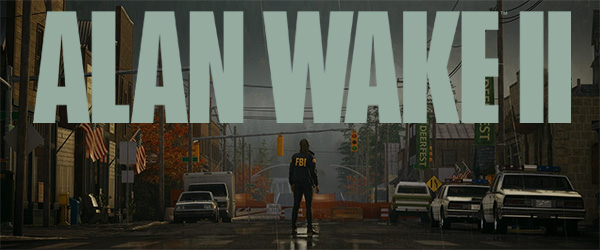
I'll give Remedy this bit of credit: in a world overrun with soul-less, design-by-committee, live-services and vehicles for micro-transaction economies, Alan Wake 2 is a game that actually has a strong creative vision and personality. It follows in the footsteps of Hideo Kojima and Death Stranding by being completely confident in itself and being un-abashedly weird. And just like with Death Stranding, that means that sometimes Alan Wake 2 is genius; other times it's confoundingly stupid and hackneyed!
It's hard even to classify Alan Wake 2 into a single genre. That goes for both narrative genre and also ludic genre. In both cases, it's kind of all over the place. At the most reductionist level, it follows the basic formula of a modern horror game: exploring creepy environments to find keys for doors, fighting monsters as an over-the-shoulder 3rd-person shooter, solving puzzles, and managing a limited inventory. So it's a "horror game", right? In fact, sometimes, it's seriously scary and disturbing. But other times, I'm questioning its "horror" status while I'm laughing out loud to a deliberate joke, or bored out of my mind because nothing scary or particularly exciting has happened in hours. Yet other times still, it's farcically campy or schlocky, and un-intentionally laughable. It's story is ridiculously out there in its concepts and execution, but somehow every beat of the plot is set up and signposted as clearly and obviously as the neon signs that point the player to the next objective in the Dark Place.
Plot twists are signposted more clearly and obviously than the neon signs that often guide the player through levels.
It's also frequently up its own ass. It is, after all, a fictional story about the power of fiction to alter reality (and our perception of reality). It even features the lead designer as a self-insert character within the story. Though surprisingly, he made himself a secondary character instead of one of the 2 playable protagonists. So it's not really about him, but he still found a way to make the entire plot revolve around that secondary character.
In the mind's eye
I feel that Alan Wake 2 is consistently at its best when its sitting firmly in its horror-mystery mode. As such, the opening couple hours of the game really pulled me in and hooked me. The game's main quest and side content are split up into various "cases" for the FBI agent protagonists to solve. There's a mechanic in which the player can retreat into Agent Saga Anderson's "Mind Space", which is an imaginary office room in which she sorts through all the clues she's gathered and strings them together on an imaginary wall in order to fit the puzzle pieces of the mystery together. Each time the player discovers a critical piece of information in the game world, it will show up in the Mind Space's filing cabinet as a new file in a case folder. Putting the clues together in the right way will unlock new lines of inquiry, and can even reveal the next objective.
Agent Anderson can review the known evidence in her imaginary Mind Space office.
Apparently, the actual game doesn't even pause, and continues to play in the background while the player is in the Mind Space. Even though the Mind Space is a full-screen environment, the character can still be attacked by enemies in the "real world". At first, I thought this would be obnoxious, but after the first time I was attacked while trying to re-arrange items on the case board in the Mind Space, I learned my lesson. After that, I actually came to realize that that needing to find a safe, peaceful space in order to let the character think about clues they've discovered (and how to proceed), really helps to emphasize the danger and stakes of the situation.
Arranging the clues in the Mind Space is not very difficult or complicated. It's not like having to solve a person's fate in Return of the Obra Dinn, or anything like that. Most of the time, the process is just going through the motions. Even when there are multiple options for where a piece of evidence can go, the solution can be easily brute-forced without the player having to know anything about what's going on.
The Case Board is an immersive quest log and objective tracker.
Even so, the Mind Space is a creative idea for presenting objectives, quest logs, story summaries, and characterization. The Mind Space at least tries to force the player to have to engage with the events of the story in a meaningful and immersive way. The player has to at least pretend to know how the various events of the story, the characters, and the McGuffins you find all fit together in the broader story in order to progress the main story or side quests.
And in fact, the entire game is about the interplay between the audience and the fiction. For most of the story, it's about the ability of fiction to re-shape people's perception of reality, but as the game goes on, it becomes more and more about the audience's ability to shape or re-shape the actual fiction. It emphasizes that any creative work is made up of both the voices of its creator(s) and also the interpretation and reception of the audience. This has always been true, with all forms of fiction and story-telling, but it's even more true with video games.
[More]
70bf8397-0bac-4efb-82b9-fb0c24ee8da7|1|5.0
Tags:Alan Wake, Alan Wake 2, Remedy, PS5, horror, fiction, shooter, mystery, investigation, light, dark, shadow, flashlight, forest, paranormal, music, cult, Federal Bureau of Investigation, Federal Bureau of Control
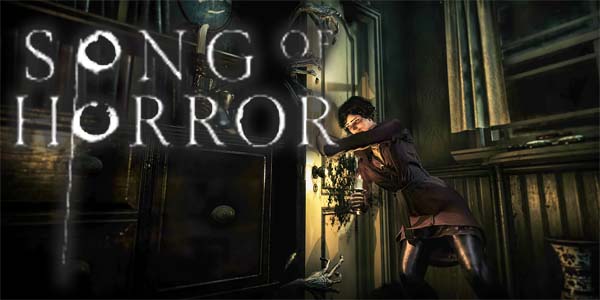
Not only is it really great to play an indie horror game that captures the slow and thoughtful nature of old-school survival horror, but it's also refreshing to play a good old fashioned gothic horror game. So many indie horror games come off as feeling a bit pretentious with their reliance on suppressed guilt twists for their psychological horror plots. Song Of Horror bucks that trend by being a straight-forward horror story about haunted houses, possessed artifacts, and otherworldly mysteries.
Song Of Horror also ups the stakes by featuring a cast of multiple playable characters, each of whom can be killed off (and removed from the rest of the story) if the player screws up. So not only do we literally not know what eldritch abomination may lie around any given dimly-lit corner, or behind any creaky old door, but if you're not careful, whatever is around that corner or behind that door might put a premature end to a given character's life and story.
Strut and fret your hour upon the stage, and then ...
Song Of Horror was originally sold as an episodic indie horror game on Steam, but the collection of all episodes was released for console as a single game in 2021. It somehow slipped under my radar until last month, when YouTube recommended a video about it by Mert Kay Kay. Each episode includes 3 or 4 playable characters to choose from, each of whom can be permanently killed off if you fail to avoid or escape from the phantasms that haunt each episode. If a character dies, all the items and notes that they've collected will be dropped on the floor at the spot of their death, and that location will be marked on the next character's map. So you don't really lose any progress if a single character dies. If you lose all the characters in a given episode, however, then it's "Game Over"!
Each episode will introduce one or more new characters, but old characters can also re-appear as playable characters if they survived the previous episode(s). Thus, losing a character in an early episode may have the longer-term consequence of reducing the player's available lives (to borrow a term from old arcade parlance) for future episodes, and reducing your margin of error.
Each episode has 3 or 4 playable characters, each of whom can permanently die.
But even if you do manage to screw up and get all 4 characters killed in any given chapter, you only have to restart that chapter. Song Of Horror won't delete your save file and force you to redo the entire game. Each chapter takes 2 -- maybe 3 -- hours to complete on a first-playthrough, and can be done in well under an hour if you know what you're doing. It's actually a loss of progress that is somewhat on par with dying in an old Resident Evil game after doing a fair chunk of exploration without backtracking to a save point.
The legitimate threat of permanently losing a character will naturally raise the stakes of the game and of the horror. It will force the player to play cautiously, to be observant of your surrounding and of context clues in the environment, to pay close attention to sounds and shadows, and to not barge through every door in a rush. In fact, it may do this more effectively than even a game like Resident Evil. Dying doesn't mean simply restarting with the same character and retrying the set piece that got you killed. Dying means permanently losing that character, and having to try again with a new character. Restarting at a checkpoint doesn't simply reset the stakes, it doubles-down on them!
Furthermore, the actual jump scares and dangers are semi-randomized. You won't necessarily encounter the same jump scare or the same monster at the same place and time in any 2 playthroughs. This also keeps things tense, because even on a replay (whether it be a whole new playthrough, or just a respawn with a different character), you can't just memorize all the places to avoid.
[More]
0ffa3716-e34f-4cd6-a026-763157eedc54|0|.0
Tags:Song of Horror, Protocol Games, Raiser Games, horror, cosmic horror, gothic horror, H.P. Lovecraft, perma-death, music, sound, light, dark, Silent Hill
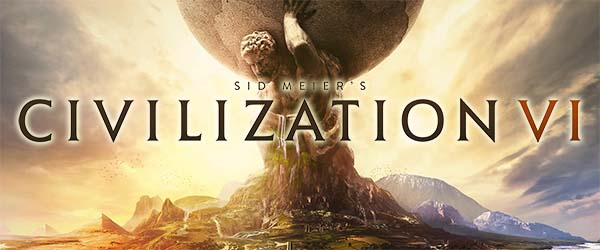
With the New Frontiers Pass for Civ VI over, an "Anthology" edition of Civ VI on sale, and no news at all regarding future DLC or expansions, I'm assuming that Firaxis has finished with Civ VI. As such, I want to look back on the game and reflect on the things that I liked most about it, and the things that annoyed me the most.
After the lifespan of Civilization V had ended, I wrote up a pair of retrospective blogs about my personal Top 10 Good Ideas and Top 10 Bad Ideas that went into that game. I'll be doing the same thing now with Civ VI.
I want to stress that this is a list of 10 good and bad ideas -- not necessarily good and bad mechanics. Some of the good ideas will be ideas that I like in principle (or on paper), but which might need more iteration before they truly work as intended. In contrast, there may be some bad ideas that work fine mechanically, but which hurt the "flavor" or theming of the game, in my opinion.
This is, of course, a subjective list of personal favorite and disliked concepts in the game. I'm sure there will be a lot of disagreement, and some of the things I write here will probably be somewhat controversial with the rest of the player base. So I'm interested in reading others' feedback. So if you agree with any of my points, or you vehemently disagree, feel free to post a comment and share your thoughts.
This content is also available in video essay format via YouTube.
This first post will cover my personal Top 10 Good Ideas, and I will follow it up with the next post being about the Top 10 Bad Ideas. [More]
549df3d2-8086-446d-bb11-35103ccef5b9|1|5.0
Tags:Civilization VI, Civilization VI: Rise and Fall, Civilization VI: Gathering Storm, Civilization VI: New Frontiers Pass, Sid Meier's Civilization, retrospective, top 10, music, Christopher Tin, Baba Yetu, agenda, wall, scout, skirmisher, ranger, diplomacy, alliance, disaster, climate change, barbarian, city state, leader

One of my biggest criticisms with the Gods & Kings expansion pack for Civilization V was that none of the features added really felt all that fresh. They were just redesigns of old features that were present in previous games. Granted, they were also the most highly-requested features by the player community, but as concepts, nothing really felt new or original.
The new expansion, Brave New World changes all of that by adding never-before-seen concepts to the game, and they add a great deal of flavor and dramatically change the way that the game unfolds.
Table of Contents
A few more of the missing concepts from Civilization IV are re-introduced with a new coat of paint in Civilization V: Brave New World: trade routes and a world resolution system. Both systems are implemented differently than in the previous game, and both are kind of hit-or-miss this time around
I have long been asking for the introduction of some kind of international trade route mechanic to be added to Civ V. Without such a feature, the vanilla game (and Gods & Kings) were missing one of the key incentives to maintain peaceful relations with your neighbors. Well now we have such a feature. In some ways, it's a step forward from Civ IV's completely non-interactive trade routes, but it's also a bit clumsy.
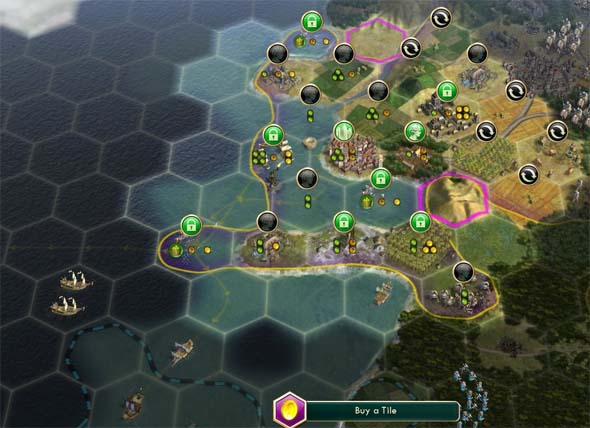
Coastal cities might seem weaker due to the lack of gold on sea resources, but sea trade routes are more profitable and have longer range than ground routes, so coastal cities are still valuable.
[More]
003f33b0-d930-43c5-8b65-1d2ae950b00a|2|5.0
Tags:Civilization V: Brave New World, Civilization V, Sid Meier's Civilization, Civilization, Firaxis, 2K Games, expansion, PC, Steam, strategy, grand strategy, turn-based strategy, tactics, trade, trade route, archaeology, literature, art, music, culture, United Nations, UN, world congress, gold, William Morgan Sheppard, Civilization IV, Civilization V
This review was originally published 01/21/2011 on Game Observer (now defunct as of 05/13/2014). It has been republished here for archival purposes.
Across-the-board interface improvements and incredible new Pro Mode make this the definitive music-rhythm game!
This review is a bit belated. This is mostly due to the fact that I didn’t want to write a full analysis of the game until I had a chance to play the new PRO guitar mode, the controls for which weren’t available publicly until late December. So if you’re still on the fence about purchasing this game even though it’s been out since October, I hope this review helps.
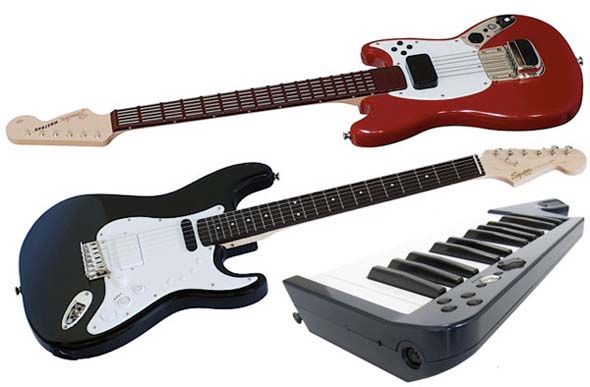
Three new controllers for PRO Mode (top to bottom):
Fender Mustang controller (available late November 2010) has 102 buttons to simulate the lower 17 frets.
Fender Stratocaster Midi guitar (available spring 2011) is a console-agnostic, fully-functioning, 6-stringed guitar equipped with pressure sensors in the neck for finger-placement detection.
MadCatz Keytar (available at game release, but sold separately) is a two-octave midi keyboard that can be used to play keys, guitar, or bass parts of songs.
Analysts and sales numbers may be suggesting that the music-rhythm genre is dying, but Harmonix isn’t letting that stop them from trying to innovate. Rock Band 3 is a very ambitious project that adds a whole new instrument (the keyboard) and attempts to incorporate REAL INSTRUMENTS into the gameplay. I am thrilled to say that both of these new marquee features work excellently!
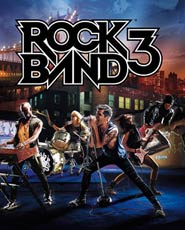
The game’s menus and interface have also been streamlined to include more filters for selecting songs and new menu widgets for each player that they can open and close anytime they want to change settings, drop in or out, customize their characters, and so forth. Speaking of character customization, you now have much more options for creating your characters’ faces by mixing, matching, and editing different parts of the face (similar to the customization options allowed in The Sims).
I bet you all want to know about how the new PRO Mode feature works, so I won’t waste anymore time, and I’ll dive right into this ground-breaking new feature: [More]
4720f3ff-2990-4db6-a80d-21d83b58c965|0|.0
Tags:Rock Band 3, review, Rock Band, PRO Mode, Electronic Arts, EA, Harmonix, MTV Games, music, music-rhythm, PS3, Wii, XBox 360
|

| 12 | | | | | | | 60 | | 11 | | | | | | | 55 | | 10 | | | | | | | 50 | | 09 | | | | | | | 45 | | 08 | | | | | | | 40 | | 07 | | | | | | | 35 | | 06 | | | | | | | 30 | | 05 | | | | | | | 25 | | 04 | | | | | | | 20 | | 03 | | | | | | | 15 | | 02 | | | | | | | 10 | | 01 | | | | | | | 05 |
|